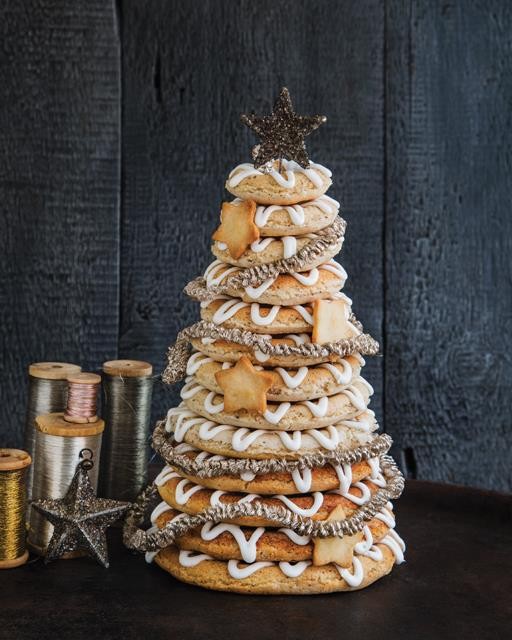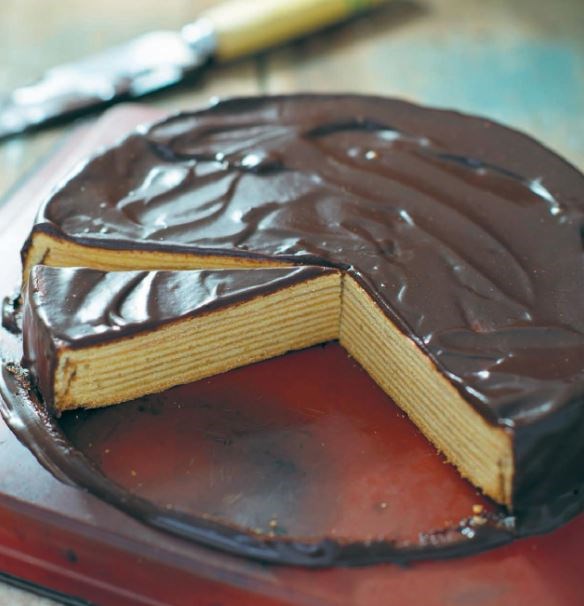This week: Kransekake and Baumkuchen cakes, cookbook and product giveaways, EYBD Previews and more!
December 18, 2020 by JennyYou may have guessed that I have an unhealthy obsession with all things baking. One of this week’s (many) bakes that pulled me into its sugary vortex is the Kransekake cake. Its towering magnificence has me making promises to myself to dust off my kransekake molds.

Kransekake from Sweet Paul Magazine, Winter 2015 (#23) by Paul Lowe
The kransekage which translates to wreath cake is a traditional Danish (kransekage) and Norwegian (kransekake/tårnkake) confection, usually eaten on special occasions such as weddings, baptisms, Christmas, 17th of May (Norway’s Constitution Day), or New Year’s Eve.
Kransekage takes shape with a series of concentric rings of cake, layered on top of each other in order to form a steep-sloped cone shape – often 18 or more layers – glued together with white icing. Kransekage cake rings are made with almonds, sugar, and egg whites. The ideal kransekage is hard to the touch, yet soft and chewy.

One variation of this showstopper is a snowflake version using a Snowflake set of cutters. The bonus is you can use the cutters for individual cookies or stack them beautifully for a twist on the original.

Photo: By Sándor Háaz, International Kürtősh Kalách Trade Corporation
Another cake I have been dreaming about for years is the “spit cake” sounds yummy right? Remember there are a few definitions for spit. I remember watching an episode of Unique Sweets or some similar show and both my son Andrew and I were quite taken with this cake.
A spit cake is a European cake made with layers of dough or batter deposited, one at a time, onto a tapered cylindrical rotating spit. The dough is baked by an open fire or a special oven, rotisserie-style. Generally, spit cakes are associated with celebrations such as weddings and Christmas. The spit can be dipped in a thin dough, or the dough can be poured or rolled on the spit.
Baumkuchen (aka tree cake as it resembles the rings of a tree) and Baumstriezel (or chimney cakes) are German varieties of spit cake. Baumkuchenspitzen, German for “Tree Cake Points,” are miniature versions of Baumkuchen that are created from the cake scraps that fall during the cake’s creation on a spit. These pieces are typically coated in chocolate and sold separately – sign me up!
Pictured below is a German tree cake (Baumkuchen) from Poh Bakes 100 Greats.

I hope you enjoyed this trip down all things cake. Have you ever tried or made any of the cakes mentioned above? Let me know in the comments.
Thanks to our members who used our affiliate links while doing their shopping. The commissions earned help us to index more books and make improvements to the site. Please remember to click here before shopping Amazon USA * Amazon Canada * Amazon UK anytime. And remember an EYB gift certificate is a great idea for the cookbook lover.
The last week on the blog
Since our last roundup, Darcie has written articles entitled:
- Chefs predict food trends for 2021
- A trifling matter
- Why you should set your desserts on fire
- London chefs share their Christmas dinner secrets
Darcie’s weekly food news antipasto is shared every Sunday #foodnews brings up these information-packed posts from the most current to the first one.
Over the last few week, I’ve shared:
- Cookies from around the world or around the block
- December 2020 Eat Your Books Cookbook Club Summary (includes our January & February cooking options and our choices for our year-long books)
- January 2021 Great Big Cookbook Club Roundup
Giveaways have been posted for
- The Book on Pie and a JK Adams Pastry Board Giveaway
- Baking Cookbook Bundle Giveaway
- Toblerone Cookbook Giveaway
Other articles of interest:
- The Kindle cookbook and holiday deals and 2021 cookbook preview are being updated frequently.
- Ideas on how EYB can work better for you
Jenny and the EYB Team
Featured Recently Indexed Titles

- Bollywood Kitchen: Home-Cooked Indian Meals Paired with Unforgettable Bollywood Films by Sri Rao
- Broth & Stock from the Nourished Kitchen: Wholesome Master Recipes for Bone, Vegetable, and Seafood Broths and Meals to Make with Them by Jennifer McGruther
- Kimchi: Essential Recipes of the Korean Kitchen by Byung-Hi Lim and Byung-Soon Lim
- Death by Burrito: The Cookbook: Mexican Street Food to Die For by Shay Ola
- The Cook’s Apprentice: Tips, Techniques and Recipes for New Foodies by Stephanie Alexander
- Pie Style: Stunning Designs and Flavorful Fillings You Can Make at Home by Helen Nugent

- The Roads to Rome by Jarrett Wrisley and Paolo Vitaletti

- Lemongrass, Ginger and Mint Vietnamese Cookbook: Classic Vietnamese Street Food Made at Home by Linh Nguyen
Member Photo of the Week

Chocolate peanut butter pretzel [cupcakes] from Robicelli’s: A Love Story, with Cupcakes: With 50 Decidedly Grown-Up Recipes by Allison and Matt Robicelli submitted by member bwhip
Have you uploaded any of your own photos yet? Learn more! Please remember to update your profile with your Instagram name if you would like to be tagged in any photos that we share!
Featured Online Recipe

Roasted winter vegetable lasagna from Eats Well with Others by Joanne Bruno
EYBDigital Previews
Recently we uploaded our 831st EYBDigital Preview where a selection of full sample pages is available for the following cookbooks.
Learn more about EYBDigital Previews.
Note: To learn why you cannot add all EYBDigital Preview recipes to your Bookshelf, please read this Help page.

- 3 recipes from Festa Italiana: Recipes Inspired by the Festivals and Traditions of Rural Italy by Letizia Mattiacci

- 3 recipes from Gluten-Free Kitchen: How to Enjoy Pasta, Breads, Cakes, Cookies and More on a Gluten-free Diet; a Practical Guide for Healthy Eating with 165 Recipes by Catherine Atkinson

- 3 recipes from Damn Good Dumplings: 60 Innovative Favorites for Every Occasion by Stratis Morfogen

- 3 recipes from Baking Happiness: Delicious, Colorful Desserts to Brighten Every Day by Rosie Madaschi

Cookbook Giveaways
Click on the Bold Blue Link Below to Enter

- Enter our US giveaway to win one of three copies of The Sourdough School: Sweet Baking: Nourishing the Gut & the Mind by Vanessa Kimbell Expires December 29th, 2020
- Enter our US/UK giveaway to win one of three copies of Jikoni: Proudly Inauthentic Recipes from an Immigrant Kitchen by Ravinder Bhogal Expires December 31st, 2020.
*Publishers thank us for our continued patience while awaiting the arrival of prizes as warehouses are not operating at full capacity yet and it appears things will only get slower as the winter season takes hold. The cookbook giveaway roundup shares all current giveaways.
Categories
- All Posts (7075)
- Antipasto (2205)
- Author Articles (250)
- Book News (944)
- Cookbook Giveaways (996)
- Cookbook Lovers (262)
- Cooking Tips (116)
- Culinary News (299)
- Food Biz People (558)
- Food Online (800)
- Holidays & Celebrations (277)
- New Cookbooks (154)
- Recipes (1520)
- Shelf Life With Susie (231)
- What's New on EYB (134)
Archives
Latest Comments
- Indio32 on Four outstanding independently published cookbooks worth your attention
- nvernon on Four outstanding independently published cookbooks worth your attention
- fayegibson on Four outstanding independently published cookbooks worth your attention
- Pizzacat13 on Balli Balli – Cookbook Giveaway and Quick Bites
- Laura1 on For the Love of Lemons by Letitia Clark – Giveaway
- fms95032 on For the Love of Lemons by Letitia Clark – Giveaway
- fms95032 on 20 Amici – 40 Ricette Cookbook Giveaway
- fms95032 on French at Heart – Cookbook Giveaway
- Shelmar on Tea innovations
- dzm on 20 Amici – 40 Ricette Cookbook Giveaway